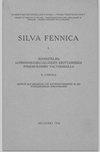Genetic variation in phenology and growth among and within Norway spruce populations from two altitudinal transects in Mid-Norway
IF 1.7
3区 农林科学
Q2 FORESTRY
引用次数: 12
Abstract
Progenies from open pollinated cones collected in natural populations of Norway spruce ( (L. Karst.)) distributed along two altitudinal transects in Mid-Norway were tested in the nursery, in short term tests and in long-term field trials. The populations showed clinal variation related to the mean annual temperatures of the populations, with the earliest bud flush and cessation of shoot elongation and lowest height at age nine years for the high altitude populations. Within population variation was considerable as the narrow sense heritability for these traits was 0.67, 0.31 and 0.09 in one transect and 0.55, 0.18 and 0.14 in the other transect, respectively. Lammas shoots occurred in the short term trials with large variation in frequency between years. There was significant family variation for this trait, but also interactions between populations and year. The variance within populations was considerably larger in the populations from low altitude compared to the high-altitude populations. Significant genetic correlations between height and phenology traits and damage scores indicate that families flushing early and ceasing growth late were taller. Taller families also had higher frequencies of damages. Selection of the top 20% families for height growth in short term tests at age nine years gave a simulated gain of 11% increased height growth at age 18 years in long term trials at altitudes similar to those of origin of the populations. The gain was negative when high altitude populations were selected based on testing in the lowland.Picea abies挪威中部两个垂直样带挪威云杉种群间和种群内物候和生长的遗传变异
在挪威中部沿两个垂直样带分布的挪威云杉(L. Karst.)自然种群中采集的开放授粉球果的后代在苗圃、短期试验和长期田间试验中进行了试验。种群表现出与种群年平均温度相关的临床变异,高海拔种群在9岁时萌发最早,芽伸长停止,株高最低。这些性状在一个样带的狭义遗传力分别为0.67、0.31和0.09,在另一个样带的狭义遗传力分别为0.55、0.18和0.14。在短期试验中,南丫节发生的频率在不同年份之间变化很大。这一性状存在显著的家族变异,但也存在种群和年份之间的相互作用。与高海拔人群相比,低海拔人群的群体内部差异要大得多。高、物候性状和损伤评分之间存在显著的遗传相关性,表明发红早、停止生长晚的家系较高。个子高的家庭遭受伤害的频率也更高。在9岁时的短期测试中,选择身高增长前20%的家庭,在与人口起源相似的海拔高度进行的长期试验中,18岁时的身高增长模拟增加了11%。当根据低地的测试选择高海拔种群时,增益为负。挪威云杉
本文章由计算机程序翻译,如有差异,请以英文原文为准。
求助全文
约1分钟内获得全文
求助全文
来源期刊

Silva Fennica
农林科学-林学
CiteScore
3.50
自引率
11.10%
发文量
21
审稿时长
3 months
期刊介绍:
Silva Fennica publishes significant new knowledge on forest sciences. The scope covers research on forestry and forest ecosystems. Silva Fennica aims to increase understanding on forest ecosystems, and sustainable use and conservation of forest resources. Use of forest resources includes all aspects of forestry containing biomass-based and non-timber products, economic and social factors etc.
 求助内容:
求助内容: 应助结果提醒方式:
应助结果提醒方式:


